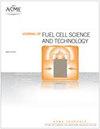Study on a Vapor-Feed Air-Breathing Direct Methanol Fuel Cell Assisted by a Catalytic Combustor
引用次数: 4
Abstract
Feeding vaporized methanol to the direct methanol fuel cell (DMFC) helps reduce the effects of methanol crossover (MCO) and facilitates the use of high-concentration or neat methanol so as to enhance the energy density of the fuel cell system. This paper reports a novel system design coupling a catalytic combustor with a vapor-feed air-breathing DMFC. The combustor functions as an assistant heat provider to help transform the liquid methanol into vapor phase. The feasibility of this method is experimentally validated. Compared with the traditional electric heating mode, the operation based on this catalytic combustor results in a higher cell performance. Results indicate that the values of methanol concentration and methanol vapor chamber (MVC) temperature both have direct effects on the cell performance, which should be well optimized. As for the operation of the catalytic combustor, it is necessary to optimize the number of capillary wicks and also catalyst loading. In order to fast trigger the combustion reaction, an optimal oxygen feed rate (OFR) must be used. The required amount of oxygen to sustain the reaction can be far lower than that for methanol ignition in the starting stage.催化燃烧辅助蒸汽进气式直接甲醇燃料电池的研究
向直接甲醇燃料电池(DMFC)进料汽化甲醇有助于减少甲醇交叉(MCO)的影响,便于使用高浓度或纯甲醇,从而提高燃料电池系统的能量密度。本文报道了一种催化燃烧室与蒸汽进气式DMFC耦合的新型系统设计。燃烧器作为辅助热源,帮助液态甲醇转化为气相。实验验证了该方法的可行性。与传统的电加热方式相比,基于该催化燃烧器的操作可以提高电池的性能。结果表明,甲醇浓度和甲醇气室温度对电池性能有直接影响,应进行优化。对于催化燃烧室的运行,有必要对毛细芯数和催化剂负载进行优化。为了快速触发燃烧反应,必须使用最佳供氧速率(OFR)。维持反应所需的氧气量可能远低于开始阶段甲醇点火所需的氧气量。
本文章由计算机程序翻译,如有差异,请以英文原文为准。
求助全文
约1分钟内获得全文
求助全文
来源期刊
自引率
0.00%
发文量
0
审稿时长
6-12 weeks
期刊介绍:
The Journal of Fuel Cell Science and Technology publishes peer-reviewed archival scholarly articles, Research Papers, Technical Briefs, and feature articles on all aspects of the science, engineering, and manufacturing of fuel cells of all types. Specific areas of importance include, but are not limited to: development of constituent materials, joining, bonding, connecting, interface/interphase regions, and seals, cell design, processing and manufacturing, multi-scale modeling, combined and coupled behavior, aging, durability and damage tolerance, reliability, availability, stack design, processing and manufacturing, system design and manufacturing, power electronics, optimization and control, fuel cell applications, and fuels and infrastructure.

 求助内容:
求助内容: 应助结果提醒方式:
应助结果提醒方式:


